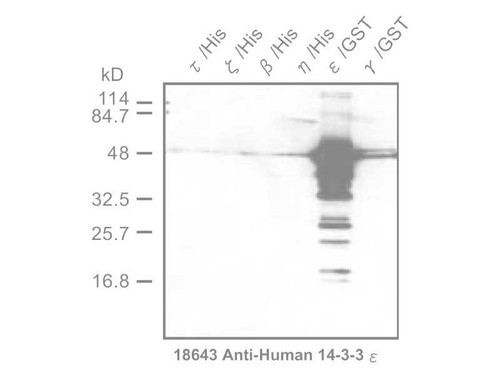The 14-3-3 proteins are a family of conserved regulatory molecules expressed in all eukaryotic cells. A striking feature of the 14-3-3 proteins is their ability to bind a multitude of functionally diverse signaling proteins, including kinases, phosphatases, and transmembrane receptors. This plethora of interacting proteins allows 14-3-3 to play important roles in a wide range of vital regulatory processes, such as mitogenic signal transduction, apoptotic cell death, and cell cycle control. The cell cycle checkpoint plays an important role in maintaining the integrity of cells. The G1 arrest is due to p53-mediated induction of the cyclin-dependent kinase inhibitor p21WAF1/CIP1/SDI1, but the basis for the G2 arrest is unknown. Recently, one of the 14-3-3 protein family members, 14-3-3sigma, was shown to be regulated by p53 and to play a role in the G2-M-phase checkpoint. 14-3-3 sigma was cloned by expression cloning through cyclin-dependent kinase 2 (CDK2) association. 14-3-3 sigma shares cyclin-CDK2 binding motifs with different cell cycle regulators, including p107, p130, p21 (CIP1), p27 (KIP1), and p57 (KIP2), and is associated with cyclin. For research use only, not for use in diagnostic procedures.
- application:
- WB, IHC
- Catalog number:
- 18649
- Datasheet:
- formulation:
- Lyophilized product from 1% BSA in PBS containing 0.05% NaN3
- immunogen:
- Synthetic peptide for a part of Human 14-3-3 gamma
- MSDS:
- notes:
- For research use only, not for use in diagnostic procedures.
The datasheet for this product (see above) is intended to serve as an example only. Please refer to the datasheet provided with the antibody for precise details. - Protocol:
- purification:
- Affinity Purified with synthetic peptide
- size:
- 100 µg
- specificity:
- React to Human 14-3-3 β, γ, ε, ζ, η, τ
- storage:
- Lyophilized product, 5 years at 2 - 8 °C, Solution, 2 years at -20 °C
- Species:
- Human
- Host:
- Rabbit








